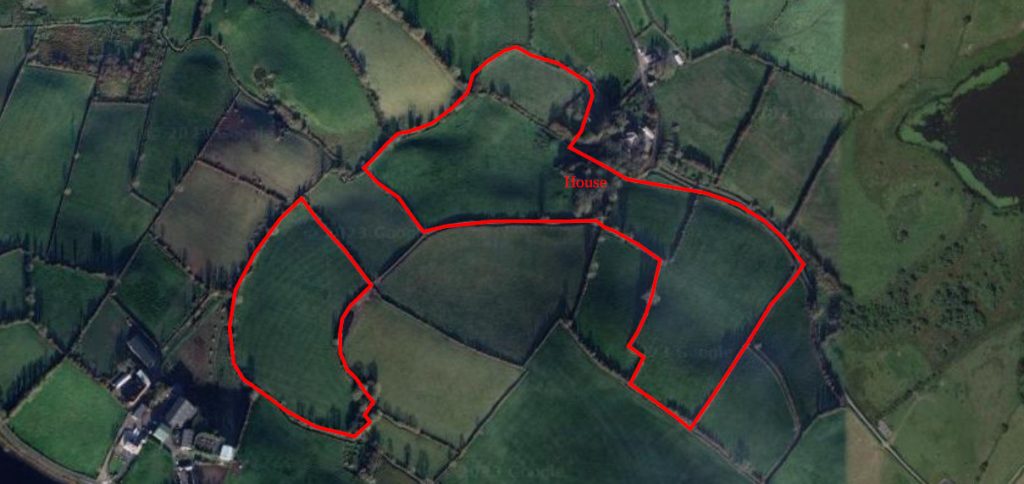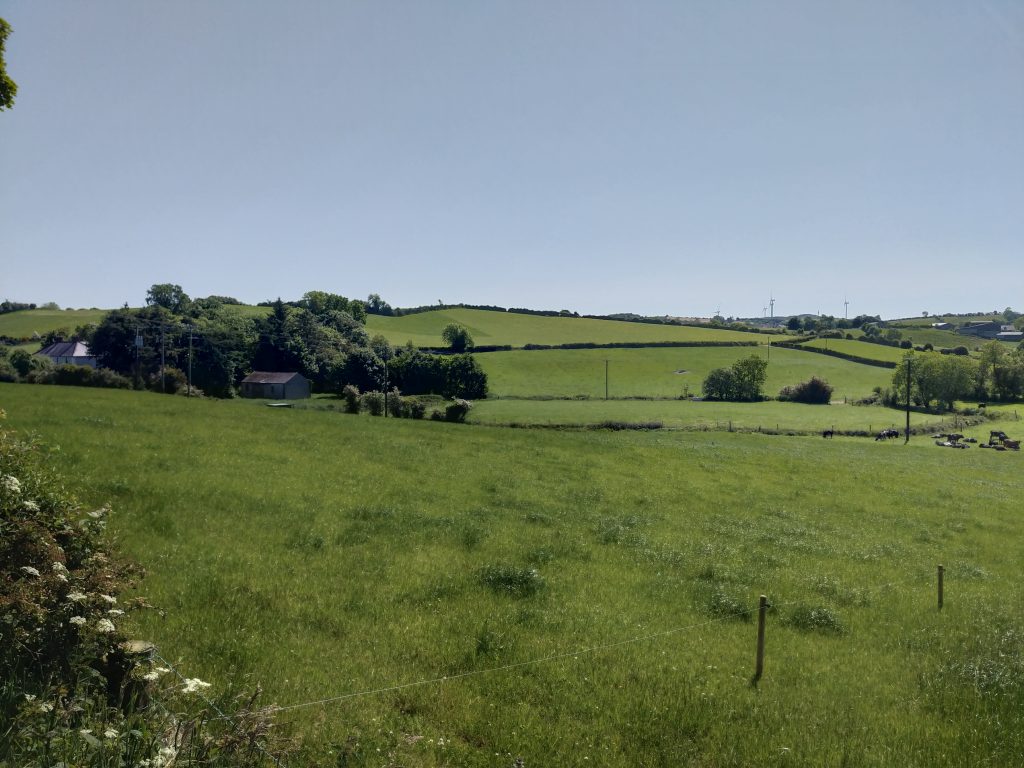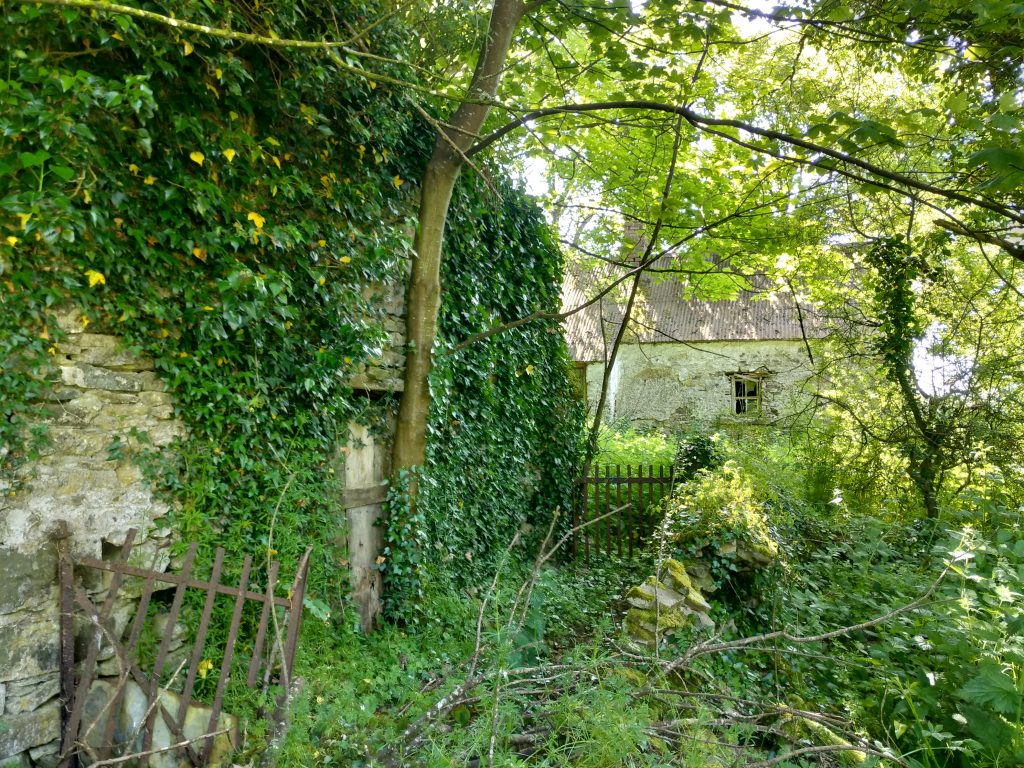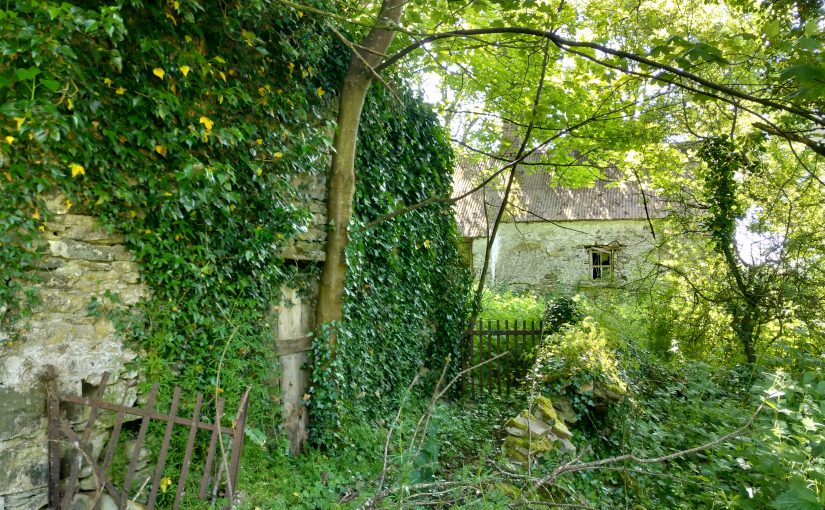Because we have so many documents relating to the traditional Irish harper Patrick Byrne, there are some interesting side-lines that can be followed up, which are not strictly part of his life. The story of the farm at Beagh is one of these stories.
We have two wills made by Patrick Byrne. The first was made in November 1846, and the second was made in May 1859. Both of these wills mention the farm at Beagh.
The relevant section of the November 1846 will reads:
…I will and direct that the farm in the townland of Beagh, the interest of which I have purchased be given to my brother in law Patrick Ward, and his wife Alice my sister who now hold possession of the said farm…
Will of Patrick Byrne, 2nd November 1846 (Warwickshire County Record Office, CR229/box18/5, transcription online by Keith Sanger, 2011)
The May 1859 will reads:
…I request Evelyn Philip Shirley esqr to act as my Executor requesting him to allow my Brother in Law Patrick Ward & his wife my sister Alice to continue in the farm in Beagh <& after their deaths> I wish their son James to have it, should he die I should wish Thomas Freeman son of my sister Anne to succeed to it…
Will of Patrick Byrne, 29th May 1859 (Public Record Office of Northern Ireland D3531.G.6)
Ownership of the farm
We have two clear statements in the wills which we have to try to understand in the context of the times. For an overview of the system of buying and selling the tenancy of a farm at this time, you can look at Guinnane & Miller’s 1996 article or Martin Dowling’s entry in the Encyclopedia of Irish History and Culture. In summary, a farm was rented on an annual basis from the aristocratic landowner who owned all of the farms in a large area; but the right to be the tenant was bought and sold between the tenants. So a prospective tenant would buy the tenancy from the previous occupier, and would then become the new tenant of the aristocratic landlord.
The the first will states clearly that Patrick Byrne had purchased the interest in the farm. Evelyn Philip Shirley was the landlord of all the farms in the area, and the second will seems to indicate that as landlord, Shirley had some say in who got to be tenant. Either that or this is Byrne being very polite, or using legal wording guided by his patron Shirley who may have slightly disapproved of the heritable tenancies and the buying and selling of tenancies by tenants.
Also there is the slightly non-standard setup that Patrick Byrne says he has purchased the farm, and is including it in his will, yet it is his sister Alice and her husband Patrick who are the actual tenant farmers living there.
Dating the purchase
We can wonder when Patrick Byrne bought the farm; it was obviously before 1846. Patrick Byrne had got his Royal Appointment on 6th Jan 1841. Presumably he had started earning serious money through his work as a traditional Irish harper playing on the wire-strung Irish harp, and perhaps he decided to put some of his money into land. It would also be a great help to his sister, to get her and her husband a farm to live in and work on.
Neither Patrick Byrne nor Patrick Ward are listed in the 1832 Tithe Applotment Books for Beagh, which suggests to me that Byrne had not yet bought the farm in 1832.
An Gorta Mór had started in Ireland in the autumn of 1845, and autumn 1846 was much worse, with the first deaths from starvation being recorded then, but the following year 1847 was the worst. Is it a co-incidence that Patrick Byrne wrote his will in Novermber 1846, with the farm in Beagh as the first item mentioned? Had he just bought it?
Working out where it was
Beagh is the next townland west of Greaghlone, where it seems that Patrick Byrne’s parents had lived and where he had been born and raised. See my post Patrick Byrne part 1: 1790s to 1822 for more about Greaghlone and about Patrick Byrne’s family.
The 1832 Tithe Applotment Books for Beagh list two people called Byrne holding land there, Gerald and Peter, though the Tithe books don’t tell us where in the townland the holdings were. These may or may not be related to Patrick Byrne, perhaps uncles or more distant cousins. But I don’t have any way of knowing if these Byrnes were related to Patrick’s family. There are no Byrnes at all in Beagh in the 1861 Griffith valuation. And anyway, Byrne tells us in the first will that he had purchased “the interest of” the farm, so it was obviously not a family farm that he had inherited.
In the will in November 1846, Patrick Byrne says that his sister Alice and her husband Patrick Ward were living at the farm. Patrick Byrne’s papers contain some letters dated 1863, between Alice Ward and Evelyn P. Shirley, the executor of Patrick’s will after he had died (PRONI D3531.G.6). In the letters, her address is given as “Alice Ward, Beagh, Northlands, near Carrickmacross”.
I checked the Griffith valuation of 1861 for the townland of Beagh, and I found Patrick Ward holding house and land no.1 from the landlord Evelyn P. Shirley, totalling a bit over 23 acres. We can see on the Griffiths map that the house was just south of the mill, and we can see the extent of the fields, curving round the northern flank of the drumlin.
It is interesting that Griffith does not mention Patrick Byrne, just listing Patrick Ward as holding the farm from Evelyn P Shirley.



This interactive streetview shows the entrance to the farm. The field on the left is part of the farm; the house is along the lane around the corner, concealed in the trees.
Patrick Byrne at the farm
Obviously Patrick Byrne was not a farmer, living at the farm; he was a professional musician touring in England, Scotland and Ireland, staying at the houses of aristocratic patrons. The farm at Beagh was the home of his sister Alice Ward, who he seems to have been very close to. We have a couple of snippets of information about him going to the farm to visit Alice. These are from Alice’s correspondence with Evelyn Shirley, after Byrne’s death.
…It was in Dundalk hospital that he died, for, he took a car and left the Hotel to come out to the country to my place, but was unable from weakness to proceed…
Letter from Alice Ward to Evelyn P. Shirley, Mon 13 Apr 1863 (PRONI D3531.G.6)
Beagh is about 20 miles from Dundalk.
…many times when my Brother stopped at our residence…
Letter from Alice Ward to Evelyn P Shirley, Mon 20 Apr 1863 (PRONI D3531.G.6)
Patrick Byrne died on 8th April 1863. His sister Alice was quite involved with the aftermath, trying to visit him in hospital, and then having a correspondence with Shirley (who was Byrne’s patron, and the executor of Byrne’s will, as well as being Alice’s landlord). However, that is a different story for yet another blog post in the future.
Later history of the farm
We know from the first will that the farm was occupied by Patrick Byrne’s sister Alice, and her husband Patrick Ward, from before 1846; we know from the second will that they had a son James before 1859. We can try and track down Alice and her family in the records, to see what happened later.
I checked the online deaths register, and I have found entries which I think probably tell the story of Alice and her descendents. We have Alice Ward who died at Beagh on 18th July 1876, aged 85, “widow of a farmer”. This looks very much like Patrick Byrne’s sister Alice; the death was reported by James Ward (who signed with an X), “Occupier Beagh”. We also have Patrick Ward who died at Beagh on 23 December 1878 aged 66; He looks like he may be Patrick Byrne’s brother-in-law. He is listed as a farmer, a widower, and the death was reported by James Ward (who signed with a X) who is listed (I think) as “inmate occupier deceased”.
Now there is obviously a problem here, because if this is sister Alice and her husband Patrick and their son James, then Alice cannot have been a widow before her husband died. I also think that Alice’s age may be a great over-estimate, since it doesn’t match the rest of the people I have found. At present I don’t know what is wrong, whether one of these entries is a different person not part of the family. Or whether this is a simple error in the register.
Anyway moving on, it seems that James Ward, Patrick Byrne’s nephew, inherited the farm and continued living there. We find James Ward and his wife Annie and two children John and Annie, living in a house in Beagh in the 1901 census and the 1911 census. Unfortunately the census does not pinpoint where exactly each house was, but it seems likely that this is the same place. James Ward died in Beagh on 18th August 1930, aged 85. He is listed as a widower I think; a farmer; and the death was reported by “John Ward, Son, present at death, Beagh”. I presume this is the same James, Patrick Byrne’s nephew. We have mis-matched ages; the age at death would imply he was born in 1844-5; in the 1901 census he is given as 59, i.e. born 1841-2; in the 1911 census he is listed as 71, i.e. born 1839-40. I suppose we could say he was born between 1839 and 1845, so he would have been aged between 14 and 20 when Patrick Byrne made the 1859 will.
John Ward his son would by this reckoning be Patrick Byrne’s great-nephew. John Ward died in Beagh on 18th November 1957, aged 71, listed as a farmer. The death was reported by Michael Carroll, his son-in-law. But I am not finding Michael Carroll listed later in Beagh, and so I wonder if 1957 was when the farm house was abandoned, in the state we see it today?
As a final aside, Frank McNally writing in the Irish Times Wed Mar 24 2010, remembers his grandmother Annie, who he says was James’s daughter, Patrick Byrne’s great-niece. She would have been John Ward’s sister, presumably born and raised in the farm house at Beagh, and listed there with her brother and their parents in the 1901 and 1911 censuses. However, she must have moved away. She may be the Annie Ward of Greaghlone (the next townland East from Beagh), who married Edward Murray of Tonaneeve (which is the next-but-one townland East from Greaghlone) in the Catholic church of Magheracloone on the 19th Feb 1919. Her death record says she died on 20th December 1967 in Tonaneeve, aged 79, a widow. The death was reported by her son Francis Murray.
I am sure that there is loads more we could find out about the family and descendents, about the site and the buildings on it, about documents in the Shirley papers in Belfast or in Warwickshire dealing with rents, and other things that I am not thinking of. But this post lays down some of the basic information and frames what I have found out so far. Please add a comment below or email me if you have more info or have ideas to take any of this further.

I love these stories! And the photos and the street view only make them more tangible. Little puzzle pieces that get us a tiny step closer to the harpers of old…
I love theses stories. Sad he never really lived there. It would be a great historical landmark site for the HHSI society since it seems abandoned.
Have the society use a grant to buy it, Sell some of the farm land, fix up the house and create a permanent HHSI site with research library and classrooms and a concert hall!!!